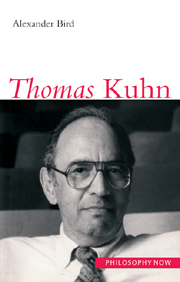2 - Normal and revolutionary science
Summary
Theoretical history of science
The Structure of Scientific Revolutions is a work in the theoretical history of science. It is not philosophy, although Kuhn's theoretical standpoint meant that he had to engage deeply with philosophy. Nor, unlike his first book The Copernican Revolution, is it straight history of science, detailing and explaining a particular past episode or scientific development. Kuhn's treatment of the history of science in The Structure of Scientific Revolutions can be regarded as having two aspects. The first we may call descriptive – he details what he sees as a pattern or regularity in the development of the various sciences – the cycle of normal science, crisis and revolution. The second aspect is the explanatory side in which he tries to find an underlying explanation, some general feature of science that accounts for the pattern – this is Kuhn's theory of paradigms. In this chapter I shall discuss the descriptive aspect of his project, and in the next I shall examine the explanatory claim.
Kuhn himself did not clearly distinguish between the two elements of his project, instead combining the two as a single picture of science and its workings. This is one of the reasons for the vagueness and multiplicity of uses some of his critics found in his employment of the paradigm concept. Since this theoretical, explanatory concept is frequently used in his descriptions of scientific change, it can be difficult to assess his descriptive claims.
- Type
- Chapter
- Information
- Thomas Kuhn , pp. 29 - 64Publisher: Acumen PublishingPrint publication year: 2000



